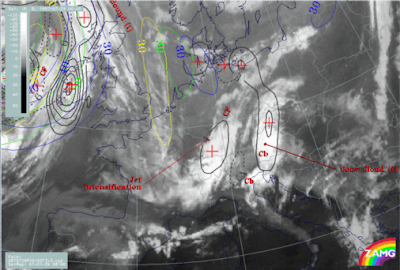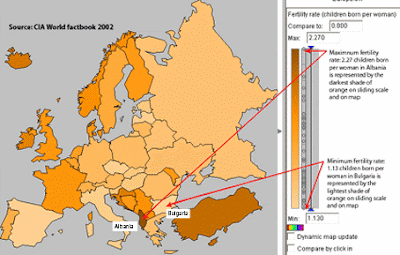
Monday
Unclassed Choropleth Maps

Standardized Choropleth Map
DOQQ
DRG
DLG
DEM
Bilateral Graph
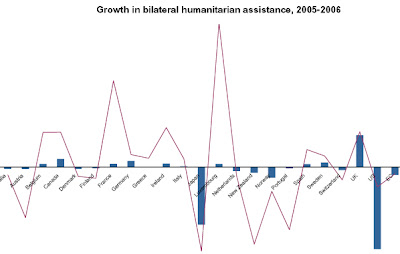
Lorenz curve
Index Value Plot
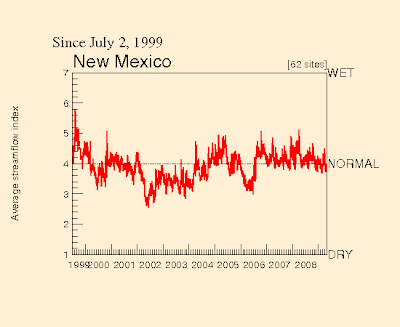
Isopleths
Isopach
Isohyets
Isotachs
Cartographic Animations
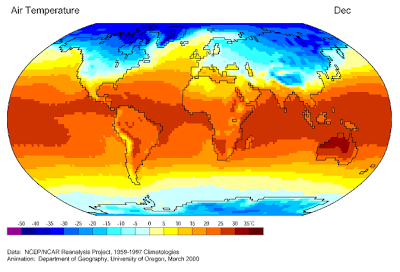
The cartographic animation to the left, when seen in motion, shows the air temperature from 1959 through 1997. This was created, or at least published, by The University of Oregon in March of 2000. What the viewer can see is an actual progression of all the months of all the years that this study contains data for.
Isoline Map
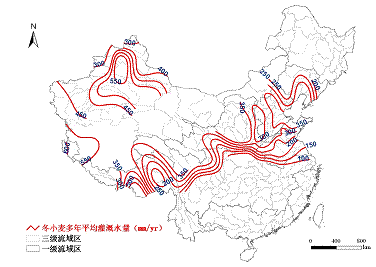
This is an isoline map of China. It displays the average water amounts used for winter wheat irrogation across these regions.
The URL for this map is: http://www.iwhr.com/webadmin/uploadfiles/wuhy2008714174748275.gif
Hypsometric Map
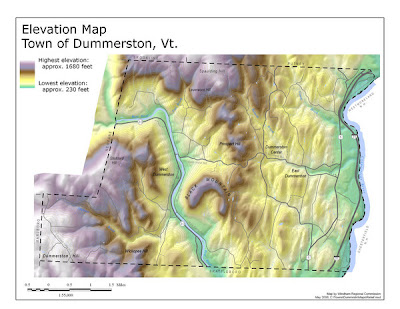
Cadastral Map
Sunday
Star Plot
Correlation Matrix
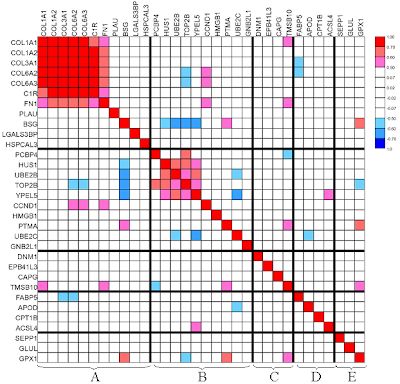
Similarity Matrix
Stem & Leaf Plot
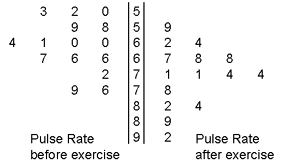
This is a back-to-back stem and leaf plot/graph. It is showing that one graph can be made from two different sets of data simply by keeping the numbers that do not change in the middle. For example, this graph shows pulse rate before and after exercise, but the middle numbers can be maintained, and therefore only one graph is needed instead of two.
Parallel Coordinate Graph
Box Plot
Triangular Plot
Windrose
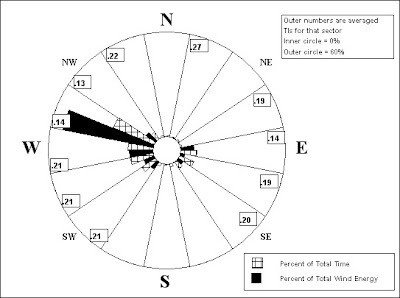
The windrose testing graph to the left was downloaded from windtesting.com. The focus is looking into setting up turbines, and therefore using alternative fossil fuel energy. Graphs like this are more than helpful in background research being done in order to try to move into a different technology.
Climograph
Population Profile
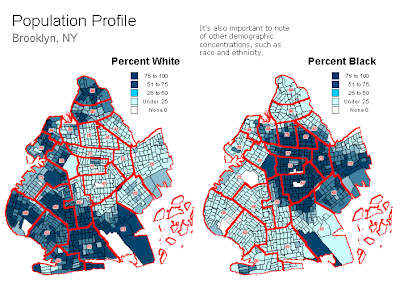
Scatterplot
Histogram
Black & White Aerial Photo
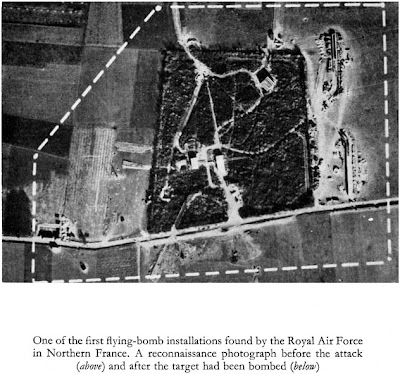
Infrared Aerial Photo
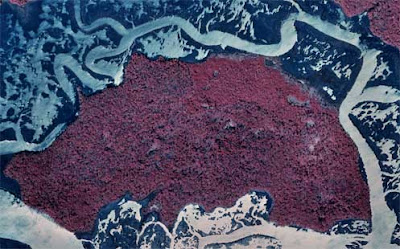
An Infrared aerial photo can loosely be described as "Photography in which an infrared optical system projects an image directly on infrared film, to provide a record of point-to-point variations in temperature of a scene." (answers.com). The photo to the left is an infrared photograph taken of Grover Island, and the colors clearly show that the top of the island/middle of the island (which is only 1.4 miles across...from east to west) seems to have the most activity/heat. The URL for this photo can be found at: http://images.google.com/imgres?imgurl=http://www.camdencountylandtrust.org/grover-aerial-for-web.jpg&imgrefurl=http://www.camdencountylandtrust.org/Grover%2520Island.htm&usg=__88QgpZ_sBXX9t42hp2htXp3Fytc=&h=310&w=497&sz=36&hl=en&start=40&um=1&tbnid=Afu4pMDoA6Z7EM:&tbnh=81&tbnw=130&prev=/images%3Fq%3Dinfrared%2Baerial%2Bphoto%26ndsp%3D18%26hl%3Den%26rls%3Dcom.microsoft:*:IE-SearchBox%26rlz%3D1I7GZFA%26sa%3DN%26start%3D36%26um%3D1
Tuesday
Bivariate Chloroleth map
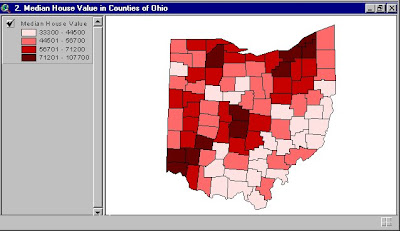
Classed Chloropath Maps
Range Graded Proportional Circle Map
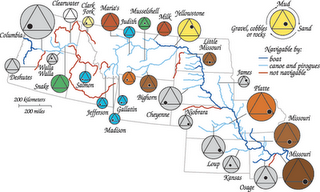
A range graded proportional circle map is supposed to be a proportional circle map that "better" represents data circles with relation to their data. The map to the left better depicts the range (size and color wise) that seems to better represent its data. The URL for the map to the left is: https://blogger.googleusercontent.com/img/b/R29vZ2xl/AVvXsEjSF91vjH2s9YtJX6-PGpGNDKUZIh36GUBEKa_EF6uzDgXqEae3v5EITLKuhJV__eIyOKYaSy3widJ3vHCGIUYd9yjulItCeAF8XHJlnEbxUMTE7BNaVleZ8pfz3nEPrs0si_OrYmLrh3eo/s320/Range+graded+proportional+circle+map.gif
Continuously Varibale Proportioanl Circle Map
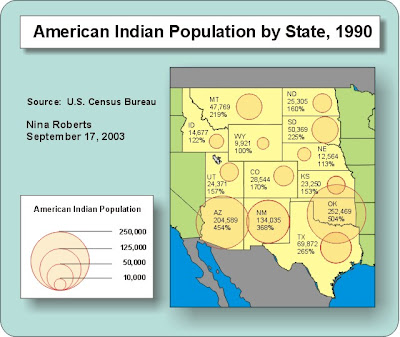
A continuously variable proportional circle map is, apparently, a map which uses circles to create "point data." The photo on the left is a map, with info dated September 17, 2003, was compiles to show Native American populations by certain states. Its URL is: http://vin25maps.blogspot.com/2009/04/continuously-variable-proportional.html
ISOBAR

ISOBAR, essentially, utilizes a line to connect areas with equel atmospheric pressure(s). The map to the left is for a "swell" forecast (for surfuers), and has an emphasis on the Atlantic. The URL for this map is: http://images.google.com/imgres?imgurl=http://www.swell-forecast.com/en/tutorials/info_isobar_e.gif&imgrefurl=http://www.swell-forecast.com/en/tutorials/isob_e.htm&usg=__nWK07OgmB_gWsv5FCAZjWIs1oh8=&h=432&w=576&sz=24&hl=en&start=5&tbnid=mepsPbtKo5zsAM:&tbnh=101&tbnw=134&prev=/images%3Fq%3DISObar%26gbv%3D2%26ndsp%3D18%26hl%3Den
LIDAR
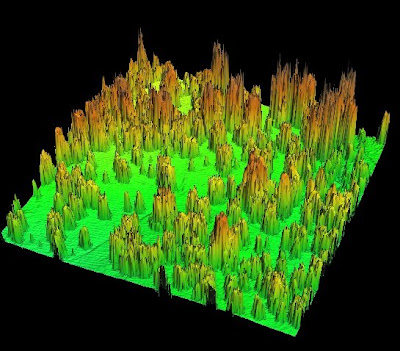
LIDAR radar is very similar to radar except that it uses laser lights instead of microwaves to produce its images. The picture to to the left Three-dimensional Image of is a canopy Structure with Pulsed LIDAR. This image's URL was taken from: http://images.google.com/imgres?imgurl=http://nature.berkeley.edu/biometlab/images/Lidar%2520sample%2520Tonzi.jpg&imgrefurl=http://nature.berkeley.edu/biometlab/fieldpics.html&usg=__6BTeDIBI8B6wNTtvBDCnxEzkG70=&h=478&w=545&sz=120&hl=en&start=32&tbnid=UJkidOms6N9ynM:&tbnh=117&tbnw=133&prev=/images%3Fq%3Dlidar%26gbv%3D2%26ndsp%3D18%26hl%3Den%26sa%3DN%26start%3D18
Followers
Blog Archive
-
▼
2009
(50)
-
▼
April
(49)
- Unclassed Choropleth Maps
- Standardized Choropleth Map
- DOQQ
- DRG
- DLG
- DEM
- Bilateral Graph
- Lorenz curve
- Index Value Plot
- Isopleths
- Isopach
- Isohyets
- Isotachs
- Cartographic Animations
- Isoline Map
- Hypsometric Map
- Cadastral Map
- Star Plot
- Correlation Matrix
- Similarity Matrix
- Stem & Leaf Plot
- Parallel Coordinate Graph
- Box Plot
- Triangular Plot
- Windrose
- Climograph
- Population Profile
- Scatterplot
- Histogram
- Black & White Aerial Photo
- Infrared Aerial Photo
- Bivariate Chloroleth map
- Classed Chloropath Maps
- Range Graded Proportional Circle Map
- Continuously Varibale Proportioanl Circle Map
- ISOBAR
- LIDAR
- Doppler Radar
- Statisical Maps
- Proportional Circle Maps
- Chloropath Maps
- Cartogram
- Flow Map
- DOT Distribution Map
- Propaganda Maps
- PLSS Maps
- Thematic Map
- Topographic map
- Planimetric map
-
▼
April
(49)








